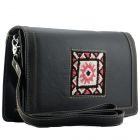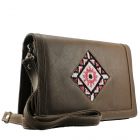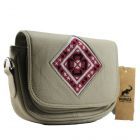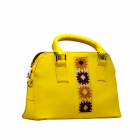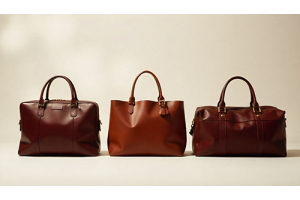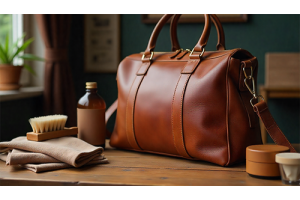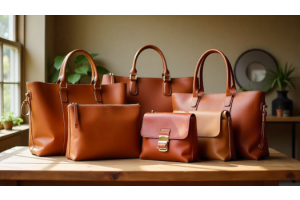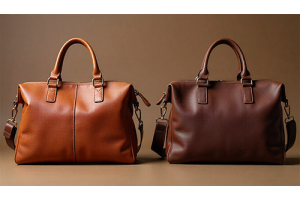From Tradition to Trend: Leather Bags in Sustainable Fashion
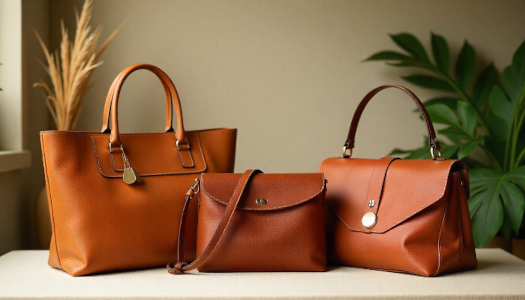
From Tradition to Trend: Leather Bags in Sustainable Fashion
Leather bags combine timeless style with sustainable practices. Using eco-friendly materials and responsible craftsmanship, they offer durability and elegance while supporting a greener fashion future.
- 1. Introduction – From Tradition to Trend
- 2. Craftsmanship – Traditional Leather Techniques
- 3. Sustainable Practices in Leather Production
- 4. Eco-Friendly Materials and Tanning Methods
- 5. Style and Durability – Leather Bags That Last
- 6. Modern Trends – Leather Bags in Contemporary Fashion
- 7. Conclusion – Embracing Sustainable Fashion
- 8. FAQs
Introduction – From Tradition to Trend
Leather bags have a rich history, rooted in centuries of skilled craftsmanship and practical use. Traditionally, they were valued for their durability, functionality, and the artistry involved in handcrafting each piece. Over time, these timeless essentials have evolved into modern fashion statements, reflecting both style and individuality. Today, as sustainability becomes a key concern in the fashion industry, leather bags are embracing eco-friendly practices such as vegetable tanning, ethically sourced hides, and low-waste production methods. This transformation allows them to honor traditional techniques while meeting contemporary demands for responsible, environmentally conscious fashion. From classic work totes to chic weekend bags, leather bags now embody a perfect balance between heritage, style, and sustainability, proving that fashion can be both elegant and ethical.
- Leather bags have a rich history rooted in centuries of skilled craftsmanship.
- Traditionally valued for durability, functionality, and artistry.
- Modern leather bags have evolved into fashion statements reflecting style and individuality.
- Sustainable practices now include vegetable tanning, ethically sourced hides, and low-waste production.
- Combines traditional techniques with eco-conscious, contemporary fashion.
- From work totes to weekend bags, they balance heritage, style, and sustainability.
Tip
When selecting a sustainable leather bag, it’s important to focus on both quality and eco-conscious practices. Look for bags made from ethically sourced hides and vegetable-tanned leather, as these processes reduce harmful chemical use and environmental impact. Consider craftsmanship and durability—well-constructed bags last longer, reducing the need for frequent replacements and minimizing waste. Pay attention to brands that prioritize low-waste production, use recycled materials for linings or hardware, and maintain transparency about their supply chain. Style should also be versatile; choosing timeless designs ensures your bag remains fashionable for years, supporting a more sustainable approach to consumption. Finally, caring properly for your leather bag, with regular cleaning and conditioning, extends its lifespan and reinforces its value as both a durable and eco-friendly accessory.
Craftsmanship – Traditional Leather Techniques
Traditional leather craftsmanship is the backbone of high-quality leather bags, reflecting centuries of skill and meticulous attention to detail. From selecting the finest hides to hand-stitching each seam, every step showcases the artisan’s expertise. Techniques like hand-cutting, tooling, embossing, and burnishing ensure that each piece is not only durable but also unique in design. These methods prioritize precision and longevity, making leather bags that can withstand daily use while aging gracefully. Beyond aesthetics, traditional craftsmanship emphasizes minimal waste and thoughtful use of materials, aligning naturally with sustainable fashion principles. By preserving these time-honored techniques, modern leather bags can honor heritage while offering eco-conscious consumers an accessory that is both elegant and responsibly made.
- Traditional leather craftsmanship reflects centuries of skill and meticulous attention to detail.
- Selection of the finest hides ensures quality and durability.
- Hand-stitching, hand-cutting, tooling, embossing, and burnishing create unique and long-lasting designs.
- Techniques focus on precision, longevity, and minimal material waste.
- Preserving these methods allows modern leather bags to honor heritage while embracing sustainable practices.
Style Meets Functionality
Leather bags are where style meets functionality, and this balance is achieved through traditional craftsmanship. Skilled artisans meticulously select high-quality hides, hand-stitch seams, and use techniques like tooling, embossing, and burnishing to create pieces that are both beautiful and durable. Every detail, from reinforced handles to structured shapes, ensures the bag is practical for daily use while retaining timeless elegance. This careful attention to craftsmanship not only enhances the bag’s aesthetic appeal but also extends its lifespan, reducing waste and supporting sustainable fashion practices. By merging form and function, traditional leather techniques transform ordinary bags into versatile accessories that honor heritage while serving the modern, eco-conscious consumer.
- Leather bags combine style and functionality through traditional craftsmanship.
- High-quality hides are carefully selected for durability and aesthetic appeal.
- Hand-stitching, tooling, embossing, and burnishing create unique, long-lasting designs.
- Details like reinforced handles and structured shapes ensure practical daily use.
- Traditional techniques enhance both beauty and longevity, supporting sustainable fashion.
- Merges form and function, offering versatile accessories that honor heritage and eco-conscious values.
| Aspect | Details |
|---|---|
| Style & Functionality | Leather bags balance aesthetic appeal with practical use. |
| Material Quality | High-quality hides are carefully selected for durability and elegance. |
| Traditional Techniques | Hand-stitching, tooling, embossing, and burnishing create unique, long-lasting designs. |
| Practical Details | Reinforced handles and structured shapes ensure daily usability. |
| Sustainability | Techniques extend lifespan and support eco-conscious fashion practices. |
Sustainable Practices in Leather Production
Sustainable practices in leather production focus on minimizing environmental impact while maintaining high-quality craftsmanship. Modern leather makers are increasingly adopting eco-friendly tanning methods, such as vegetable tanning, which avoid harmful chemicals and reduce water pollution. Many producers now source hides responsibly, ensuring that leather comes from ethical and traceable origins. Waste reduction is also a priority, with leftover materials being repurposed or recycled wherever possible. By combining these approaches, the leather industry can produce durable, stylish bags that respect both the planet and traditional craftsmanship, allowing consumers to make more conscious fashion choices without compromising on quality or aesthetics.
- Sustainable leather production minimizes environmental impact while maintaining quality craftsmanship.
- Eco-friendly tanning methods, such as vegetable tanning, avoid harmful chemicals and reduce water pollution.
- Hides are sourced responsibly from ethical and traceable origins.
- Waste reduction is prioritized by repurposing or recycling leftover materials.
- Combines durability, style, and sustainability, allowing consumers to make conscious fashion choices.
| Practice | Details |
|---|---|
| Eco-Friendly Tanning | Methods like vegetable tanning avoid harmful chemicals and reduce water pollution. |
| Responsible Sourcing | Hides are ethically sourced from traceable origins. |
| Waste Reduction | Leftover materials are repurposed or recycled whenever possible. |
| Durability & Style | Combines long-lasting craftsmanship with fashionable design. |
| Sustainability | Supports conscious consumer choices without compromising quality. |
Eco-Friendly Materials and Tanning Methods
Eco-friendly materials and tanning methods are at the heart of sustainable leather production. Vegetable-tanned leather, made using natural plant extracts, avoids toxic chemicals and reduces water and soil pollution. Some brands also use recycled leather or responsibly sourced hides to minimize environmental impact. Innovative linings, dyes, and hardware made from recycled or biodegradable materials further enhance sustainability. By choosing eco-conscious materials and traditional, chemical-free tanning processes, leather bags can maintain their quality, durability, and elegance while significantly reducing their ecological footprint. This approach ensures that consumers enjoy stylish, long-lasting accessories that align with modern environmental values.
- Vegetable-tanned leather uses natural plant extracts, avoiding toxic chemicals and reducing pollution.
- Recycled leather and responsibly sourced hides minimize environmental impact.
- Linings, dyes, and hardware made from recycled or biodegradable materials enhance sustainability.
- Chemical-free, traditional tanning processes preserve quality, durability, and elegance.
- Eco-conscious choices allow consumers to enjoy stylish, long-lasting, and environmentally friendly accessories.
| Aspect | Details |
|---|---|
| Vegetable-Tanned Leather | Uses natural plant extracts, avoiding toxic chemicals and reducing pollution. |
| Recycled & Responsibly Sourced Materials | Minimizes environmental impact by using recycled leather and ethically sourced hides. |
| Eco-Friendly Linings & Hardware | Uses recycled or biodegradable materials for linings, dyes, and hardware. |
| Chemical-Free Tanning | Preserves quality, durability, and elegance without harmful chemicals. |
| Consumer Benefits | Stylish, long-lasting accessories that align with environmental values. |
Style and Durability – Leather Bags That Last
Leather bags are celebrated for their unique ability to combine style with lasting durability. High-quality leather naturally withstands daily wear and develops a rich patina over time, enhancing its character and appeal. Well-crafted stitching, reinforced seams, and carefully chosen hardware ensure that these bags endure years of use without losing functionality or elegance. Beyond physical resilience, leather’s timeless design makes it a versatile accessory suitable for work, travel, and casual outings, proving that fashion and practicality can coexist. By investing in durable leather bags, consumers not only enjoy long-lasting style but also reduce the need for frequent replacements, supporting a more sustainable approach to fashion.
- Leather bags combine timeless style with lasting durability.
- High-quality leather withstands daily wear and develops a rich patina over time.
- Well-crafted stitching, reinforced seams, and quality hardware ensure longevity.
- Timeless designs make leather bags versatile for work, travel, and casual outings.
- Durable bags reduce the need for frequent replacements, supporting sustainable fashion.
| Aspect | Details |
|---|---|
| Timeless Style | Leather bags offer classic designs that remain fashionable over time. |
| Durability | High-quality leather withstands daily wear and develops a rich patina. |
| Construction | Well-crafted stitching, reinforced seams, and quality hardware ensure longevity. |
| Versatility | Suitable for work, travel, and casual outings due to timeless design. |
| Sustainability | Durable bags reduce frequent replacements, supporting eco-conscious fashion. |
Modern Trends – Leather Bags in Contemporary Fashion
Modern leather bags have evolved to reflect contemporary fashion trends while maintaining their traditional appeal. Designers are experimenting with minimalist shapes, bold colors, and innovative textures, creating pieces that cater to both style and functionality. Many brands are integrating sustainable practices, such as using eco-friendly materials and low-impact production techniques, to meet the growing demand for responsible fashion. Features like adjustable straps, convertible designs, and modular compartments enhance versatility, making leather bags suitable for work, travel, and everyday life. By blending trend-forward aesthetics with timeless durability and ethical practices, modern leather bags demonstrate that fashion can be stylish, practical, and environmentally conscious all at once.
- Modern leather bags reflect contemporary fashion while retaining traditional appeal.
- Designers explore minimalist shapes, bold colors, and innovative textures for style and functionality.
- Sustainable practices like eco-friendly materials and low-impact production meet demand for responsible fashion.
- Features such as adjustable straps, convertible designs, and modular compartments enhance versatility.
- Blends trend-forward aesthetics with timeless durability and ethical practices for stylish, eco-conscious accessories.
| Aspect | Details |
|---|---|
| Contemporary Design | Reflects modern fashion trends while maintaining traditional appeal. |
| Innovative Styles | Minimalist shapes, bold colors, and unique textures enhance both style and functionality. |
| Sustainable Practices | Eco-friendly materials and low-impact production methods support responsible fashion. |
| Functional Features | Adjustable straps, convertible designs, and modular compartments increase versatility. |
| Trend & Durability | Combines modern aesthetics with timeless durability and ethical production. |
Conclusion
Leather bags have beautifully transitioned from traditional essentials to modern fashion statements, proving that style, durability, and sustainability can coexist. By honoring time-tested craftsmanship and integrating eco-friendly practices—such as vegetable tanning, responsibly sourced hides, and minimal-waste production—these bags offer both elegance and conscience. They are versatile, practical, and built to last, making them a sustainable choice for everyday life. As consumers increasingly value ethical fashion, leather bags exemplify how heritage techniques can evolve to meet contemporary needs, bridging the gap between tradition and trend. Ultimately, investing in a well-crafted, sustainable leather bag is not just a fashion statement—it’s a commitment to quality, longevity, and the environment.
FAQs
1. What makes a leather bag sustainable?
A leather bag is considered sustainable if it is made from responsibly sourced hides, uses eco-friendly tanning processes, and incorporates low-waste production methods.
2. How can I tell if a leather bag is ethically made?
Look for brands that provide transparency about their supply chain, sourcing practices, and commitment to fair labor standards.
3. Are vegetable-tanned leather bags better for the environment?
Yes, vegetable-tanned leather uses natural plant extracts instead of harmful chemicals, reducing environmental impact.
4. Do sustainable leather bags last as long as traditional ones?
Absolutely. High-quality, sustainably produced leather bags are durable and often develop a rich patina over time, enhancing their beauty.
5. How should I care for a sustainable leather bag?
Regular cleaning, conditioning with natural leather care products, and proper storage will extend its lifespan and maintain its appearance.
6. Can sustainable leather bags be stylish?
Yes. Modern sustainable leather bags combine timeless craftsmanship with contemporary designs, offering both elegance and practicality.
7. Are recycled leather bags truly eco-friendly?
Recycled leather reduces waste by repurposing leftover materials, making it a more environmentally conscious option.
8. What features make a leather bag functional for daily use?
Features like reinforced handles, structured shapes, modular compartments, and adjustable straps enhance usability without compromising style.
9. Is investing in a sustainable leather bag worth it?
Yes. High-quality, eco-friendly leather bags are durable, stylish, and reduce the need for frequent replacements, making them a sustainable investment.
10. How do sustainable leather bags support ethical fashion?
They uphold responsible sourcing, eco-friendly production, and fair labor practices, aligning with the principles of ethical fashion.

